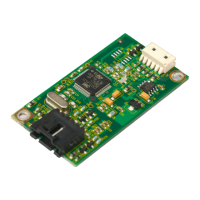
Do you have a question about the 3M Touch Screen Controller EX 111 and is the answer not in the manual?
| Product Type | Touch Screen Controller |
|---|---|
| Interface | USB |
| Operating Voltage | 5V DC |
| Resolution | 4096 x 4096 |
| Response Time | 10 ms |
| Compatibility | Windows, Linux |
| Touch Points | Single |
Information assumed for using this document, including firmware commands and potential performance impacts.
Read, understand, and follow all safety instructions before using the product.
Explains the meaning of WARNING and CAUTION signal words to indicate potential hazards and property damage.
Details risks of fire and explosion, prohibiting use in hazardous locations or outdoors without proper standards.
Addresses risks associated with improper disposal and environmental contamination from components and displays.
Provides instructions for cleaning the touch sensor surface using isopropyl alcohol and a soft cloth.
Advises on cleaning with a soft cloth, avoiding gritty materials, and careful handling of the sensor's flex tail.
Outlines support services, website resources, and information required for contacting technical support.
Directs users to the website for contact information for all 3M Touch Systems offices.
Introduces the EX121 and EX111 controllers, their features, USB interface, and linearization process.
Lists necessary items for integrating and testing the EX USB controller, including sensors, cables, and software.
Provides precautions for handling electrostatic sensitive devices during mounting and controller installation.
Details how to establish the USB data connection using the 3M™ MicroTouch™ USB communication cable.
Describes the 12-pin sensor cable connector for EX121 controllers and its pinout.
Describes the 5-pin sensor flex tail connector for EX111 controllers and its pinout.
Provides guidance on mounting the cased and uncased controllers, considering placement and screw types.
Specifies the USB bus power requirements for the controller, including voltage, current, ripple, and noise.
Refers to external documentation for sensor mounting recommendations and integration guidance.
Outlines the steps for starting up the custom system after connecting cables and mounting the controller.
Explains how the LED on the controller provides diagnostic feedback on its operating status.
Details the meaning of LED flashes and bits to diagnose various controller self-test errors and their solutions.
Continues the table of LED diagnostic codes for EX USB controllers, including resistance, backplane, and corner errors.
Guides users on installing the necessary touch driver and software for various operating systems.
Discusses the fundamentals of communicating with the EX USB controller using firmware commands.
Provides information on sending firmware commands and interpreting controller responses using vendor requests.
Lists the six available vendor requests used for controller communication, such as Calibrate, Status, and Reset.
Details the general format for USB vendor requests, including fields like bmRequestType, bRequest, wValue, wIndex, and wLength.
Explains the four types of reports sent from the controller to the host, categorized as synchronous and asynchronous.
Recommends issuing a Reset command for initializing the EX USB controller when the host system powers on.
Describes how Coordinate Data Report 1 transfers raw and adjusted coordinate data asynchronously.
Explains how the operating mode determines when the controller sends X and Y touch coordinates to the host.
Details the 2-point calibration request, its purpose, and how it maps video targets to sensor coordinates.
Explains the device response to calibration requests and how to determine calibration target areas based on display resolution.
Describes the request to gather controller status information, including power-on check errors and command completion.
Details the bmRequestType, bRequest, wValue, wIndex, and wLength fields for the Controller Status Request.
Explains the report containing controller status, including Power On Check Status, Command Status, and Touch Status.
Provides details on POC Status, Cmd Status, Touch Status, and Extended POC Status fields within the report.
Describes the request to perform a controller reset (soft or hard) to apply parameter changes or recover from errors.
Explains the response to reset requests and potential compatibility issues with drivers after a hard reset.
Details the request to restore controller settings to factory presets, followed by an automatic soft reset.
Describes the request to retrieve information identifying the controller, including type and firmware revision.
Explains the report containing controller identification, firmware revision, special features, and ROM checksum.
Details the fields within the Expanded Controller ID Report, such as Controller type, FW revisions, Features, and Checksums.
Describes the request to read configuration parameters from the controller using parameter numbers.
Explains the report sent in response to parameter data requests, containing data size and the actual parameter bytes.
Details the physical dimensions of the cased and uncased EX121 controller variants.
Lists the physical dimensions for the uncased and cased EX121 controllers in inches and millimeters.
Details board-level functions like power requirements for the EX121 controller.
Lists compliance with various regulatory standards such as CE, EN, EFT, and ESD for the EX121 controller.
Specifies the operating and storage temperature and humidity ranges for the EX121 controller.
Details performance metrics like minimum touch duration, touch resolution, ESD susceptibility, and MTBF for the EX121.
Covers EX121 touch system parameters such as accuracy, sensor compatibility, and communication protocol.
Shows the dimensions and mounting hole locations for the EX111 controller.
Lists the physical dimensions for the uncased EX111 controller in inches and millimeters.
Details board-level functions like power requirements for the EX111 controller.
Lists compliance with various regulatory standards such as CE, EN, EFT, and ESD for the EX111 controller.
Specifies the operating and storage temperature and humidity ranges for the EX111 controller.
Details performance metrics like minimum touch duration, touch resolution, ESD susceptibility, and MTBF for the EX111.
Covers EX111 touch system parameters such as accuracy, sensor compatibility, and communication protocol.